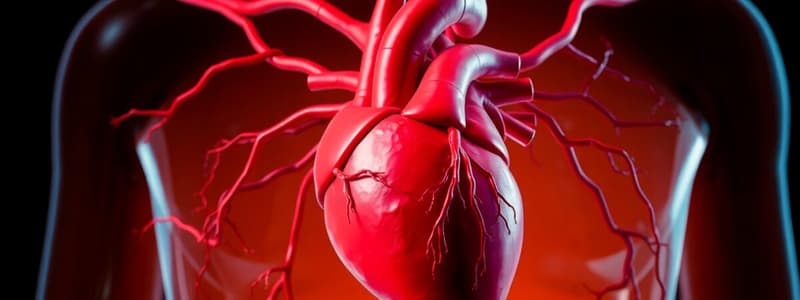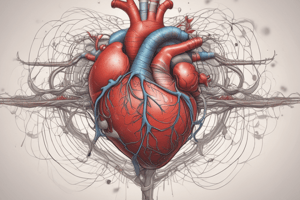Podcast
Questions and Answers
What is the main energy source for the myocardium?
What is the main energy source for the myocardium?
- Anaerobic respiration
- Aerobic respiration (correct)
- Glycolysis
- Creatine phosphate
How does the oxidative capacity of myocardial tissue compare to skeletal muscle tissue?
How does the oxidative capacity of myocardial tissue compare to skeletal muscle tissue?
- Myocardial tissue has a three-fold higher oxidative capacity. (correct)
- Myocardial tissue has a ten-fold higher oxidative capacity.
- Myocardial tissue has a lower oxidative capacity.
- Myocardial tissue has a similar oxidative capacity.
Why does myocardial tissue have a higher mitochondrial concentration than other tissues?
Why does myocardial tissue have a higher mitochondrial concentration than other tissues?
- To increase the rate of protein synthesis.
- To store more ATP for later use.
- To facilitate the transport of oxygen to the cells.
- To provide more energy for muscle contraction. (correct)
What is the primary function of the heart in the circulatory system?
What is the primary function of the heart in the circulatory system?
What is the approximate weight of an average male's heart?
What is the approximate weight of an average male's heart?
How much blood does the heart pump per beat?
How much blood does the heart pump per beat?
What percentage of total blood volume is found in the systemic circulation?
What percentage of total blood volume is found in the systemic circulation?
What percentage of total blood volume is contained within the heart at any given time?
What percentage of total blood volume is contained within the heart at any given time?
What is the relationship between blood pressure and the resistance encountered in the circulatory system?
What is the relationship between blood pressure and the resistance encountered in the circulatory system?
What is the primary factor influencing blood viscosity?
What is the primary factor influencing blood viscosity?
How does the muscular wall of arteries compare to that of veins?
How does the muscular wall of arteries compare to that of veins?
What is the main function of the muscular contractions and relaxations in the venous circuit?
What is the main function of the muscular contractions and relaxations in the venous circuit?
How does the total area resistance of the circulatory system relate to blood pressure?
How does the total area resistance of the circulatory system relate to blood pressure?
What is the effect of smaller muscular contractions in the venous circuit?
What is the effect of smaller muscular contractions in the venous circuit?
What is the relationship between the patterns of blood flow and the number of blood vessels?
What is the relationship between the patterns of blood flow and the number of blood vessels?
What is the primary mechanism by which blood is propelled forward in the circulatory system?
What is the primary mechanism by which blood is propelled forward in the circulatory system?
What is the primary function of the arterial system?
What is the primary function of the arterial system?
How do arterial walls regulate peripheral blood flow?
How do arterial walls regulate peripheral blood flow?
What happens to blood flow during physical activity according to the arterial system's function?
What happens to blood flow during physical activity according to the arterial system's function?
What occurs when the radius of an artery is decreased by half?
What occurs when the radius of an artery is decreased by half?
What are arterioles primarily responsible for in the arterial system?
What are arterioles primarily responsible for in the arterial system?
Which statement about blood flow and resistance in arteries is accurate?
Which statement about blood flow and resistance in arteries is accurate?
Why is gaseous exchange not facilitated in the arterial system?
Why is gaseous exchange not facilitated in the arterial system?
What characterizes the arterial network's distribution of blood in the body?
What characterizes the arterial network's distribution of blood in the body?
What happens to blood pressure during high intensity exercise with little resistance?
What happens to blood pressure during high intensity exercise with little resistance?
What is the effect on blood pressure when the exercise intensity is increased and the resistance is low?
What is the effect on blood pressure when the exercise intensity is increased and the resistance is low?
What is the main reason for the temporary increase in systolic blood pressure during high intensity exercise?
What is the main reason for the temporary increase in systolic blood pressure during high intensity exercise?
During high intensity exercise with low resistance, what happens to the arterioles?
During high intensity exercise with low resistance, what happens to the arterioles?
What is the expected effect on diastolic blood pressure during resistance training with body weight?
What is the expected effect on diastolic blood pressure during resistance training with body weight?
What can be said about the duration of the elevated systolic blood pressure during high intensity exercise?
What can be said about the duration of the elevated systolic blood pressure during high intensity exercise?
Which of the following is the most likely reason for the decrease in diastolic blood pressure during high intensity exercise with low resistance?
Which of the following is the most likely reason for the decrease in diastolic blood pressure during high intensity exercise with low resistance?
What is the most likely explanation for the temporary drop in diastolic blood pressure during high intensity exercise with low resistance?
What is the most likely explanation for the temporary drop in diastolic blood pressure during high intensity exercise with low resistance?
Flashcards
Myocardial Energy Source
Myocardial Energy Source
Myocardial tissue relies heavily on oxidative metabolism for energy, mainly from fatty acid breakdown. This is due to the high energy demand of continuous heart contractions.
Mitochondrial Concentration in Myocardium
Mitochondrial Concentration in Myocardium
Myocardial fibers have a significantly higher density of mitochondria compared to skeletal muscle fibers. This allows for efficient energy production from oxidative metabolism.
Heart Function: Blood Pumping
Heart Function: Blood Pumping
The heart's primary function is to pump blood throughout the body. This requires a consistent and strong pressure to deliver oxygen and nutrients.
Blood Distribution: Heart vs. Circulatory System
Blood Distribution: Heart vs. Circulatory System
Signup and view all the flashcards
Heart: Structure and Function
Heart: Structure and Function
Signup and view all the flashcards
Heart Location and Function
Heart Location and Function
Signup and view all the flashcards
Heart Size and Pumping Capacity
Heart Size and Pumping Capacity
Signup and view all the flashcards
Systematic Circulation: Role in Blood Distribution
Systematic Circulation: Role in Blood Distribution
Signup and view all the flashcards
Arteries: Oxygen Transport
Arteries: Oxygen Transport
Signup and view all the flashcards
Arterial Blood Flow: Pressure Driven
Arterial Blood Flow: Pressure Driven
Signup and view all the flashcards
Arterial Diameter: Regulation
Arterial Diameter: Regulation
Signup and view all the flashcards
Arterioles: Control Valves
Arterioles: Control Valves
Signup and view all the flashcards
Arterial Network: Distribution
Arterial Network: Distribution
Signup and view all the flashcards
Arterial Flow: Streamlined
Arterial Flow: Streamlined
Signup and view all the flashcards
Arterial Walls: Smooth Muscle
Arterial Walls: Smooth Muscle
Signup and view all the flashcards
Restricted Blood Flow: Increased Pressure
Restricted Blood Flow: Increased Pressure
Signup and view all the flashcards
Blood Pressure
Blood Pressure
Signup and view all the flashcards
Blood Pressure and Resistance
Blood Pressure and Resistance
Signup and view all the flashcards
Blood Viscosity
Blood Viscosity
Signup and view all the flashcards
Venous Pressure and Muscle Contractions
Venous Pressure and Muscle Contractions
Signup and view all the flashcards
Artery vs. Vein Structure
Artery vs. Vein Structure
Signup and view all the flashcards
Heart as a Pump
Heart as a Pump
Signup and view all the flashcards
Blood Flow Regulation
Blood Flow Regulation
Signup and view all the flashcards
Factors Affecting Blood Flow
Factors Affecting Blood Flow
Signup and view all the flashcards
Systolic Blood Pressure During High Intensity Exercise
Systolic Blood Pressure During High Intensity Exercise
Signup and view all the flashcards
Diastolic Blood Pressure During High Intensity Exercise with Minimal Resistance
Diastolic Blood Pressure During High Intensity Exercise with Minimal Resistance
Signup and view all the flashcards
Arterial Wall Pressure During Ventricular Contraction
Arterial Wall Pressure During Ventricular Contraction
Signup and view all the flashcards
Blood Pressure During Resistance Training
Blood Pressure During Resistance Training
Signup and view all the flashcards
Arterioles During Resistance Training
Arterioles During Resistance Training
Signup and view all the flashcards
Blood Pressure Increase During Resistance Training
Blood Pressure Increase During Resistance Training
Signup and view all the flashcards
Blood Pressure Response to High Intensity Exercise
Blood Pressure Response to High Intensity Exercise
Signup and view all the flashcards
High Systolic Blood Pressure During Exercise
High Systolic Blood Pressure During Exercise
Signup and view all the flashcards
Study Notes
Cardiovascular System in Exercise Physiology
- The myocardium (heart muscle) relies primarily on aerobic reactions for energy at rest and during exercise.
- Myocardial tissue has a higher oxidative capacity due to high mitochondrial concentration relative to skeletal muscle.
- At rest, myocardial energy comes from glucose/glycogen, fatty acids, and lactate.
- During moderate exercise, fatty acids and carbohydrates provide nearly equal energy substrates.
- In prolonged submaximal endurance activities, almost 80% of the myocardial energy is derived from free fatty acid metabolism.
- During intense exercise, lactate oxidation becomes a major energy source.
Cardiovascular System Structure and Function
- The heart is 11 oz in males and 11oz in females, pumping around 70ml/2.4 oz per beat
- The cardiovascular system consists of 4 main components: pump (heart), high-pressure distribution circuit (arteries), exchange vessels (capillaries), and a low-pressure collection and return circuit (veins).
- Systemic circulation contains approximately 75% of the total blood volume in capillaries, small arteries, and small veins..
- The heart contains only about 7% of the total blood volume.
- Arteries have thick walls of elastic and muscle fibers, blood moves quickly and under high pressure.
- Capillaries have very thin walls facilitating gas and nutrient exchange.
- Veins have thinner walls and one-way valves that prevent blood from pooling.
Blood Flow and Pressure
- Blood flows from the left side of the heart through arteries, capillaries, and veins, returning to the right side of the heart.
- Blood flow velocity slows and total vascular area increases as blood moves from arteries to arterioles, capillaries, venules, and veins.
- Blood pressure is highest in the aorta and progressively decreases as blood flows through the arteries, capillaries, and veins.
- Systolic blood pressure is the pressure during ventricular contraction, and diastolic blood pressure is the pressure between contractions.
- Maximal exercise increases systolic blood pressure significantly, whereas diastolic blood pressure changes are usually less and may even show a slight decrease.
- This increase correlates to increased blood flow to working muscles due to vasodilation during heavy exercise.
Coronary Circulation
- The coronary circulation supplies blood to the heart muscle.
- Coronary arteries, shaded red, and coronary veins, shaded blue, are shown in the figure.
- Obstruction of a coronary artery results in myocardial infarction.
Blood Vessel Structure and Function
- Blood vessels have walls with varying thicknesses and compositions depending on their function (arteries high pressure, capillaries rapid exchange, and veins low pressure)
- Blood vessels have smooth muscle layers that regulate blood flow rate depending on the body's needs and activities.
- Valves in veins facilitate blood flow to the heart and prevent backflow.
Studying That Suits You
Use AI to generate personalized quizzes and flashcards to suit your learning preferences.



